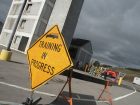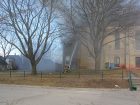
Features
Training
Trainer’s Corner: February 2015
British Columbia has changed its minimum standards of training required for fire-services personnel. In September, the Office of the Fire Commissioner implemented the Structure Firefighters Competency and Training Playbook. (You can download the 22-page playbook at www.embc.gov.bc.ca/ofc)
February 4, 2015
By Ed Brouwer
These changes affect only firefighters in British Columbia, however, certain aspects of the training are applicable to all Canadian firefighters. The new standard establishes three categories for minimum competencies required: exterior-operations level (EOL) firefighter, interior-operations level firefighter, and full-service operations level firefighter.
For small, volunteer departments, the exterior-operations level is of particular interest. According to the Playbook, EOL firefighters shall not enter any building, vehicle, dumpster or other object, if an IDLH (immediate danger to life and health) atmosphere is present. If an IDLH atmosphere is present, exterior-operation firefighters shall engage only in external fire-suppression activities, even if they possess equipment that allows them to respond at a higher level.
At least three firefighters are required to safely and effectively conduct exterior operations. If an IDLH atmosphere develops or the fire progresses beyond the object of origin, or if the environment or structure become compromised in any way, all firefighters must immediately withdraw to the exterior and combat the fire from the outside.
As a training officer, I preach firefighter safety and I believe these minimum-training standards, if implemented, can save lives. And to answer your question, yes, you can effectively fight fire from outside the fire compartment.
Years ago, the mantra of the fire service was put the wet stuff on the red stuff. Simply put, if you see fire, put water on it. Recent research from the National Institute of Standards and Technology (NIST) and Underwriters Laboratories (UL) is pushing us back to that basic fire-suppression tactic with one substantial difference; it is now recommended that firefighters hit the fire from the outside (a quick cool down if possible) before entering the building to extinguish any remaining fire. This is referred to as hitting it hard from the yard.
So, with the ability of our hose streams to reach 30 feet into a building, why are we still crawling into, or worse yet, over, the fire?
As a rookie, I was taught fire-ground tactics using the acronym REVAS; rescue, evacuation, ventilation, attack, salvage. (I still have a picture of Chief REVAS, with his spear and five feathers representing the five tactics.) REVAS is a priority list, not a random to-do list.
The REVAS model was developed in the 1980s as an upgrade to the RECEO model developed by Lloyd Layman, the late chief of Parkersburg, W.Va., in the 1950s. His tactical priorities were rescue, exposures, confinement, extinguish, and overhaul (salvage and ventilation were support functions). The upgrade was necessary as new building methods and framing materials developed. Remember, our modern-day interior furnishings are primarily made out of plastics and hydrocarbons, which ignite and burn quickly, creating atmospheres that are IDLH in a very short time. With our modern PPE and BA, we are entering fire compartments earlier and staying longer. Add the evidence of rapidly occurring flashover conditions and you have high-risk situations developing early on.
As is evident from British Columbia’s implementation of the Playbook, it is imperative for an incident commander (IC) to perform risk-management assessments and planning. It’s time for a change in tactical priorities.
Fraser Lake, B.C., Chief Dave Balding, in his Firelines column in the November issue of Fire Fighting in Canada, describes a new acronym for decision making: SLICE-RS. This model was developed by Division Chief Eddie Buchanan from Hanover County, Va. The acronym stands for size-up, location of the fire, isolate the flow path, cool from a safe distance, extinguish; rescue and salvage are added in as necessary. I want to focus on the C priority of SLICE-RS: cool the heated space from a safe location. This priority is about hitting the fire hard from the yard, and then going inside to put it out.
During size-up, the IC should assess the quickest and safest way to apply water to the fire; not necessarily to extinguish it, but to cool it down. This action slows the fire’s progress and provides a safer environment for complete knock down. Cooling down the fire space can be done by applying a water stream through a window or a door, from the exterior or from the interior. The primary goal of cooling the fire space is to reduce the super-heated gases in the thermal layer. There is no rule that says this can be done only from inside the structure. The No. 1 factor in that decision is how close you need to be to get the job done as safe as possible.
■ A few facts to consider:
- At 100 C water expands to approximately 1,700 times its original volume.
- Steam absorbs more heat faster, cooling fuel below ignition temperature.
- Steam displaces hot gases, smoke, and other products of combustion.
- In some cases, steam may smother fire by excluding oxygen.
■ Methods of water application:
Direct: Applying water directly on burning fuels is the most efficient use of water. It should be applied in short bursts until the fire darkens down.
Indirect: Applying a fog stream directed at ceiling into superheated atmosphere results in the production of large quantities of steam. This method is used where spread of fire into uninvolved spaces cannot be contained; it is not desirable when victims may be present.
Combination: Apply a ceiling-level attack combined with a direct attack on burning materials at the floor level. The nozzle is moved in a pattern with the stream edge reaching the ceiling, wall, floor and opposite wall.
■ Use of various nozzles:
Fog: Immediate reduction of heat; helps to avoid flashover; adjustable stream pattern: wide-angle fog, narrow-angle fog, straight stream.
Smooth-bore nozzle: Longer reach than a combination nozzle; capable of deeper penetration into burning material; operate at a lower pressure; less disturbance of the thermal layering.
Piercing nozzle: Used to make holes in sheet metal, aircraft, or building walls of mobile homes; extinguishes behind these surfaces.
Cellar nozzle/Bresnan distributor nozzle: Fires in cellars; other inaccessible places.
Water curtain: Delivers a flat screen of water to form a protective sheet of water; once the threat of high heat is controlled, work on fire extinguishment.
Don’t get overwhelmed in the strategic decision-making process. Tactics are different for rural and urban departments. Base your decisions on your resources, your response time and staffing. Take what works for you and do it to the best of your ability. Stay safe and remember to train as if lives depend on it, because they do.
Ed Brouwer is the chief instructor for Canwest Fire in Osoyoos, B.C., and Greenwood Fire and Rescue. The 25-year veteran of the fire service is also a fire warden with the B.C. Ministry of Forests, a wildland urban interface fire-suppression instructor/evaluator and an ordained disaster-response chaplain. Contact Ed at ebrouwer@canwestfire.org
Print this page

